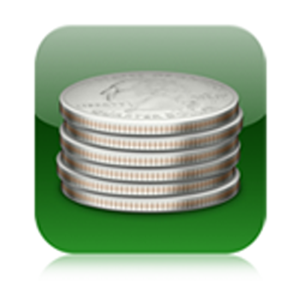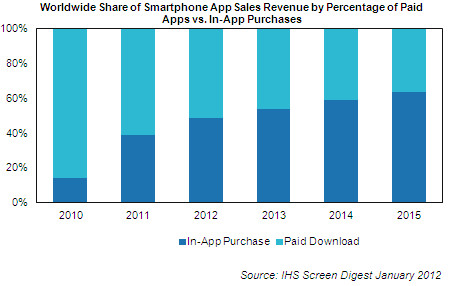Freemium Revenue Model and In App Purchases

Nowadays there are so many smartphone users that working as an app developer can guarantee you a substantial monthly income. You have to be knowledgeable in order to create something both efficiently functioning and nice-to-the-eye but the programming and the attractive design are only the one side of the coin. On the other are the marketing campaign and the way you will engage your target group.
Some people think that the only mean to gain some profit is by making paid apps. Wroooong! Did you know that 96% of all the downloaded applications for 2011 were free. This happened thanks to the so called “freemium business model”. If you don’t believe check out the current ranking at the Top Grossing Apps in iTunes or simply take a look at the chart below.
The “secret” is to stimulate the user, to give him a reason why he/she should give his/her money for your product. There is a smart psychological trick – instead of putting a price tag of $1.00, make it $0.99. 1 cent is not such a loss, but for the customer it seems better. Unfortunately not everything in the App Store is sold for $0.99 and not everybody is willing to buy something only after seeing an icon and reading some summary and comments. That’s why in 2009 a new way of gaining revenue from applications and services was introduced, different from the premium (paid) apps – the already mentioned freemium model combined with in-app purchases.

In-app purchases were firstly introduced by Apple.
The freemium revenue model can be perceived as an ancestor of the trial periods program testing. When a new piece of software was let out there was a trial period during which you exploit it for free, to see what’s updated and decide whether to purchase it or not. Such practices are still popular with antivirus systems, but let’s not get too far from the main subject of this article.
Freemium applications are – as you might have guessed – distributed for FREE. “OK but how can I make money from something that people will download without being charged?” Very simple – first release a basic version of the application that will be free. Of course basic doesn’t mean some hello-world program. Make sure that it is not primitive because after all this basic version will have to attract the user and to get under his skin. Once being impressed, the customer will immerse himself into your product and will even welcome your next move – the in-app purchases. Practically the free version of the app is kind of foundation and there are many additional functionalities and options. These functionalities and options are not part of the application but are available and can only improve the performance. That’s where the money will come from. New features and updates, virtual currency, better items and maps (especially in games) – anything that is original and interesting can be put as an in-app purchase.
Opponents of the freemium revenue model define it as an approach that baits and deceives the users. For these guys I have only one thing to say: no one compels you to download or to make any inner transactions within freemium applications! If you don’t like it simply don’t use it! Furthermore there are things for which the freemium app model is beneficial.
To begin with the fact that the user is able to “review” the app with its basics and only if he likes it to continue with the software tuning. Before the birth of in-app purchases the applications were fully equipped from the beginning and there were only updates. But if you wanted to see how a particular paid product performs and works you didn’t have another option but to buy it. The chance to like it and not to have wasted your money is 50/50.

Freemium app model prevents software piracy.
Another advantage is the reduced levels of software piracy. Experts have recorded substantial drop in the app piracy since the introduction of the freemium app model, which is logical. If before users had to look for cheaper copies of paid products now they can review the basic free version and only then make any in-app purchases if desired. Piracy, or at least part of it, stays in the past.
The third plus, which mainly concerns the developers, is connected with the process of developing and the profit, gained at the end of the day. If you want to attract people’s attention with a paid application you really have to put a lot of efforts and imagination while creating it. Of course no one guarantees that it will be a success because the rivalry in the Apple App Store, in GooglPlay and Amazon App Store is huge. It is a better idea to begin with a free application that will gather more audience only because it is not charged. In a combination with a beautiful design and smooth functionality, hardly anyone will hesitate to make a few in-app purchases or even subscribe for regular updates and new features. All in all you might even end up with more money in the pocket than if the app was paid from the beginning. Both you and your customers will be satisfied and happy.
If you check the charts below you will see that the freemium revenue model is the future of app business. Things in this field are changing really dynamically. If in 2011 the total revenue from in-app purchases was measured to be $970 million dollars, in 2016 it is estimated to be nearly $5 billion dollars. Maybe it truly is the future.


